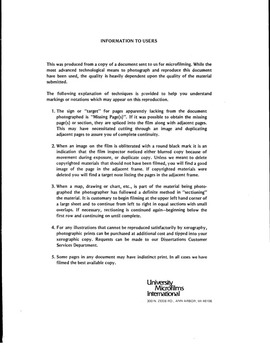| dc.contributor.author | Kunjara, Kantima, | en_US |
| dc.date.accessioned | 2013-08-16T12:28:32Z | |
| dc.date.available | 2013-08-16T12:28:32Z | |
| dc.date.issued | 1982 | en_US |
| dc.identifier.uri | https://hdl.handle.net/11244/4976 | |
| dc.description.abstract | A survey was conducted through mail among 350 randomly selected Thai students in more than 20 universities in the U.S. during December 1981-February 1982. The survey questionnaire consisted of the items which measured the key variables of the study--interpersonal communication, mass media consumption, cognitive complexity, language fluency, motivation level, and channel accessibility. It also included the student's background characteristics, general satisfaction level, attitude toward the host, and communication involvement within his own ethnic group. | en_US |
| dc.description.abstract | Further analyses of the data show that a student's length of stay in the United States, working while staying in the United States, income level, financial support, relative availability, number of other foreign countries already visited, and length of stay in those other foreign countries, were found to be the important background variables in influencing the four causal factors (i.e., English fluency, acculturation motivation, interaction potential, and mass media availability at home. | en_US |
| dc.description.abstract | The results demonstrate that language fluency, acculturation motivation, interaction potential, and availability of mass media at home are the four major causal factors that simultaneously influence the degree to which students participate in interpersonal and mass communication channels of the host society. | en_US |
| dc.description.abstract | Communication provides fundamental means by which individuals develop insights in their new environment when they move from one culture to another. The study investigated the communication patterns of Thai students who come to the U.S.A. to further their studies by (1) developing a causal path model by which individual differences in communication patterns could be explained, (2) exploring the relationship between background characteristics and communication patterns, and (3) describing developmental trends in communication patterns over years. | en_US |
| dc.format.extent | ix, 201 leaves : | en_US |
| dc.subject | Mass Communications. | en_US |
| dc.title | Communication patterns of Thai students in the process of acculturation. | en_US |
| dc.type | Thesis | en_US |
| dc.thesis.degree | Ph.D. | en_US |
| dc.thesis.degreeDiscipline | Department of Communication | en_US |
| dc.note | Source: Dissertation Abstracts International, Volume: 43-04, Section: A, page: 0964. | en_US |
| ou.identifier | (UMI)AAI8215910 | en_US |
| ou.group | College of Arts and Sciences::Department of Communication | |
